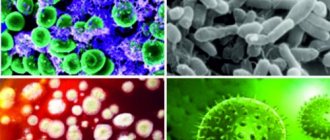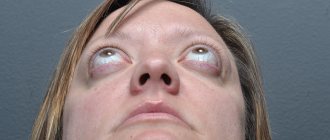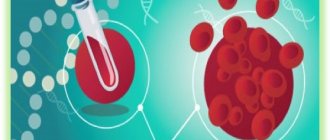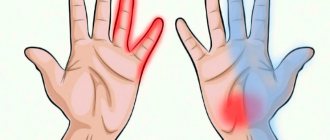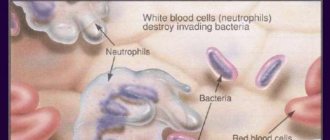48748 06 August
IMPORTANT!
The information in this section cannot be used for self-diagnosis and self-treatment.
In case of pain or other exacerbation of the disease, diagnostic tests should be prescribed only by the attending physician. To make a diagnosis and properly prescribe treatment, you should contact your doctor. We remind you that independent interpretation of the results is unacceptable, the information below is for reference only
T4 free, Free Thyroxine, FT4:
indications for use, rules for preparing for the test, interpretation of the results and normal indicators.
Indications for prescribing the study
Free thyroxine (T4 free, Free Thyroxine, FT4) is a fraction of the main thyroid hormone, thyroxine (T4), not bound to proteins.
The study is aimed at assessing thyroid function. The test is carried out:
- with clinical signs of increased or decreased activity of the thyroid gland;
- with an increase in the size of the thyroid gland (goiter);
- with a previously identified change in the level of thyroid-stimulating hormone;
- to monitor treatment for established thyroid diseases.
No. 55 Laboratory assessment of thyroid function
Free thyroxine (Free Thyroxine, FT4) Free thyroxine, not bound to transport proteins in blood plasma. Synonyms: Blood test for free thyroxine. Free T4; Free Form of Thyroxin. Brief characteristics of the determined substance Free thyroxine Thyroxine (T4) is one of the two main thyroid hormones of the thyroid gland...
Up to 1 business day
580 RUR Add to cart
Why does the body attack its own cells?
One of the reasons for this condition may be small intestinal permeability syndrome. With this syndrome, the tight junctions between the intestinal cells are opened and something that cannot penetrate there through intracellular absorption appears in the bloodstream: food particles that have not been digested to amino acids and simple sugars, gluten, casein, lectins, viruses and bacteria.
The immune system responds to this by producing antibodies. Very often, the amino acid sequences in the walls of bacteria and large molecules are similar to the amino acid sequences in the tissues of the body, in particular the thyroid gland, as a result of which the antibodies produced attack not only foreign particles, but also the organ itself, leading to an autoimmune condition.
Preparation for the procedure
- Blood should be donated for testing at the same time (if it is necessary to track the dynamics of the indicator or the effectiveness of treatment), preferably between 8:00 and 12:00.
- Discuss with your doctor the use of medications that affect the level of thyroid hormones (hormone replacement therapy, thyreostatic drugs). To assess the function of the thyroid gland, it is necessary, in agreement with the doctor, to cancel them a month before the test.
- Two to three days before the test, avoid physical activity, sports training, and stress.
- On the eve of the analysis, it is not recommended to conduct studies using radiocontrast agents.
T4 hormone during pregnancy
Thyroxine levels play a very important role in fetal development. The free hormone T4 in the first 3 months of pregnancy ensures the development and growth of the embryo's nervous system, so its deficiency can lead to various congenital pathologies. The thyroxine content in women and men is approximately the same, but during pregnancy it is not recommended to determine the level of total T4. In a pregnant woman, there is a physiological increase in the synthesis of thyroxine-binding globulin, and it binds most of the T4 in the bloodstream. Determination of total T4 during this period is not very informative, since its value will invariably be elevated, despite the fact that the free fraction of the hormone is normal.
During pregnancy, it is necessary to test free T4 hormone
, this indicator will help to objectively assess the functioning of the gland. It happens that healthy pregnant women experience a slight increase in free thyroxine that does not require treatment. But if this indicator significantly exceeds the upper limit, it is necessary to reduce the indicator through drug therapy. Treatment is carried out very carefully, under constant monitoring of thyroxine, to ensure normal development of the fetus.
Author of the article:
Kuzmina Vera Valerievna |
Endocrinologist, nutritionist Education: Diploma of the Russian State Medical University named after. N.I. Pirogov, specialty “General Medicine” (2004). Residency at the Moscow State Medical and Dental University, diploma in Endocrinology (2006). Our authors
What can affect the result
- Taking medications: iodine, thyroid hormones, thyreostatics (drugs that reduce the production of thyroid hormones), oral contraceptives (birth control pills), anabolic steroids, glucocorticosteroids, antibiotics, heparin, anticonvulsants, propranolol (a beta-blocker drug), diuretics (diuretics), etc.
- Recent thyroid surgery, radiotherapy.
- Increased body weight.
- Time to apply a tourniquet when drawing blood.
- Time of blood donation: the highest level of free thyroxine is recorded from 8:00 to 12:00, the lowest - from 20:00 to 03:00.
- Time of year: the level of free thyroxine in the autumn-winter period is lower than in summer.
- Pregnancy (free thyroxine levels fluctuate).
You can donate blood for free T4 at the nearest INVITRO medical office.
A list of offices where biomaterial is accepted for laboratory research is presented in the “Addresses” section. Interpretation of study results contains information for the attending physician and is not a diagnosis.
The information in this section should not be used for self-diagnosis or self-treatment. An accurate diagnosis is made by the doctor, using both the results of this examination and the necessary information from other sources: medical history, results of other examinations, etc. The thyroid gland is the largest gland of the endocrine system.
It accumulates iodine and produces iodine-containing hormones - thyroxine (tetraiodothyronine, T4) and triiodothyronine (T3). The synthesis of these hormones requires thyroglobulin (TG), a precursor to T4 and T3, the only source of which is the thyroid gland, but whose secretion is controlled by thyroid-stimulating hormone (TSH). TSH, in turn, is synthesized by the pituitary gland (pituitary gland), which is located at the base of the brain. The main function of the pituitary gland is to maintain a constant concentration of thyroid hormones.
Thyroid hormones are found in the blood both in free form and bound to special carrier proteins. Only free forms of hormones exhibit biological activity. Thyroxine (T4) is one of the two main thyroid hormones.
Thyroxine secretion is regulated by a feedback system that the body uses to maintain stable levels of thyroid hormones in the blood.
If the level of thyroid hormones in the blood decreases, the pituitary gland begins to produce more thyroid-stimulating hormone (TSH), which stimulates the thyroid gland, and the secretion of T4 and T3 increases.
If the level of T3 and T4 in the blood, on the contrary, increases, then the pituitary gland reduces the secretion of TSH, and the thyroid gland, in turn, produces less T4 and T3.
If the thyroid gland does not produce enough T4 and T3 due to thyroid dysfunction or insufficient TSH levels, a person will experience symptoms of hypothyroidism: weight gain, dry skin, cold intolerance, irregular periods and fatigue.
If the thyroid gland produces too much T4 and T3, a person may experience symptoms associated with hyperthyroidism: rapid heart rate, anxiety, weight loss, trouble sleeping, tremors in the hands, and dry, irritated eyes. In some cases, exophthalmos (bulging eyes) is a characteristic symptom.
Norm of free thyroxine
Reference values for thyroxine are not gender specific, but vary depending on the age of the patient.
Invitro laboratory standards for 2021:
| Age | Free T4 level, pmol/l |
| 5 days – 15 days | 13, 47-41,32 |
| 15 days – 30 days | 8,71-32,53 |
| 30 days – 6 months. | 11,42-21,89 |
| 6 months - 13 years | 10,80 -16,40 |
| 13 years – 18 years | 10,20 – 15,50 |
| over 18 years old | 9,00 – 19,05 |
Important! Standards may vary depending on the reagents and equipment used in each particular laboratory. That is why, when interpreting the results, it is necessary to use the standards adopted in the laboratory where the analysis was carried out. You also need to pay attention to the units of measurement.
Helix laboratory data, 2021:
| Age | Reference values, pmol/l |
| < 4 months | 11,5 — 28,3 |
| 4 months - 1 year | 11,9 — 25,6 |
| 17 years | 12,3 — 22,8 |
| 7 – 12 years | 12,5 — 21,5 |
| 12 – 20 years | 12,6 — 21,0 |
| > 20 years | 10,8 — 22,0 |
| During pregnancy | |
| Gestational age | Reference values |
| Until the 13th week | 12,1 — 19,6 |
| 13-28 week | 9,6 — 17 |
| 28-42 weeks | 8,4 — 15,6 |
Important! The interpretation of the results is always carried out comprehensively. It is impossible to make an accurate diagnosis based on only one analysis.
Interpretation of results in children and adults
The main reasons for the increase in the concentration of free thyroxine
- Hyperfunction of the thyroid gland with:
- diffuse toxic goiter. The development of the disease is preceded by disturbances in the activity of the thyroid gland of genetic, autoimmune or inflammatory origin. Unfavorable factors (stress, respiratory infections) can activate the thyroid gland and provoke the development of the disease;
- thyroiditis – inflammation of the thyroid gland of an infectious or autoimmune nature;
- postpartum thyroiditis. The pathology is considered a variant of autoimmune thyroiditis. The classic manifestation is temporary thyrotoxicosis, which occurs in three phases (thyrotoxicosis, hypothyroidism, recovery).
- Taking synthetic thyroid hormones.
- Excessive intake of iodine into the body (including with radiocontrast agents).
- Pathologies affecting the level and ability of specific proteins to bind hormones (hepatitis and cirrhosis lead to a decrease in the level of thyroxine-binding globulin).
- Tumors of the pituitary gland, accompanied by an increase in the level of thyroid-stimulating hormone.
The main reasons for the decrease in the concentration of free thyroxine
- Weakening of thyroid function in primary hypothyroidism, after removal of a lobe of the thyroid gland, and in case of thyroid cancer.
- Taking thyreostatic drugs.
- Iodine deficiency.
- Secondary hypothyroidism, in which the pituitary gland produces little thyroid-stimulating hormone. Causes: inflammation or neoplasm in the pituitary gland.
- Tertiary hypothyroidism, caused by a decrease in the production of thyrotropin-releasing hormone by the hypothalamus due to traumatic brain injury, inflammatory, autoimmune, and vascular disorders.
If the indicator deviates from the norm, the following studies are additionally carried out: total triiodothyronine (T3 total, Total Triiodthyronine, TT3), free triiodothyronine (T3 free, Free Triiodthyronine, FT3), total thyroxine (T4 total, total tetraiodothyronine, Total Thyroxine, TT4), thyroid stimulating hormone (TSH, thyrotropin, Thyroid Stimulating Hormone, TSH).
Why is hypothyroidism dangerous?
If free T4 is below normal for a long time, a person may have the following conditions:
- cretinism - mental retardation;
- anasarca - painful swelling of the skin;
- myxedema - swelling of the subcutaneous tissue and skin;
- adenoma of the anterior pituitary gland is a benign tumor;
- anemia - decreased level of hemoglobin in the blood;
- hypothyroid coma (mortality reaches 50-80%).
Thyroxine is involved in the formation of the internal organs of the embryo. Low T4 levels during pregnancy can negatively affect fetal development and cause miscarriage. In newborns born with hypothyroidism, in 30% of cases, underdevelopment, complete or partial absence of the thyroid gland is diagnosed.
Symptoms
A decrease in T4 does not leave its mark on the body. Most often, symptoms are not observed immediately; they can develop over months and even years, which is why contacting a doctor may be delayed.
Common symptoms when the hormone deviates from the norm:
- fast fatiguability,
- bad memory
- chills,
- problems with skin, hair, nails,
- swelling of the limbs,
- unreasonable weight gain,
- disruptions in the menstrual cycle.
These conditions should not be overlooked, as a chronic decrease in free T4 leads to coma if not diagnosed and treated.
Treatment
The body is not able to independently replace or additionally synthesize this substance if its levels are below normal. Therefore, the basis of treatment is replacement therapy, in which the patient is prescribed the missing hormones.
Most often, therapy is needed for the rest of your life, but there is nothing scary about it. The drugs are not dangerous to any other organs, supporting only the endocrine system.
Iodine deficiency also causes total and free T4 concentrations to fall below normal. Therefore, iodine-containing drugs are offered as therapy. If the course of treatment does not bring results, and the threshold of the hormone in the blood is still low, they resort to the first option.



